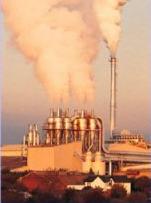Point source pollution
Point source pollution refers to any single identifiable source of pollution from which pollutants are discharged, such as a pipe, ditch, ship, or factory smokestack. Factories and sewage treatment plants are two common types of point sources. Point source pollution is distinguished from non-point source pollution, where pollutants are diffused and originate from multiple sources. The regulation and control of point source pollution are critical aspects of environmental management and are often governed by environmental laws and regulations.
Overview[edit | edit source]
Point source pollution can include a variety of contaminants, including chemicals, particles, industrial by-products, and sewage. These pollutants can have significant impacts on water quality, air quality, and overall ecosystem health. Unlike non-point source pollution, which is diffuse and can be challenging to control, point source pollution can be traced back to a specific location, making it easier to regulate and manage.
Regulation[edit | edit source]
In many countries, point source pollution is regulated under environmental protection laws. For example, the Clean Water Act in the United States requires industries and municipalities to obtain permits for discharging pollutants into water bodies. These permits specify the types of pollutants that can be discharged, the maximum allowable concentrations, and the treatment requirements before discharge.
Types of Point Source Pollution[edit | edit source]
- Industrial Discharges: Factories and industrial plants may discharge pollutants directly into water bodies or the atmosphere. These pollutants can include heavy metals, toxic chemicals, and thermal pollution.
- Sewage Treatment Plants: Facilities that treat sewage from residential and commercial sources can also be significant point sources of pollution, particularly if they are not properly managed or if they discharge untreated or partially treated sewage.
- Agricultural Facilities: Certain agricultural facilities, such as concentrated animal feeding operations (CAFOs), can also be considered point sources if they discharge pollutants directly into water bodies.
- Oil Spills: Accidental releases of oil from ships, pipelines, or drilling operations are examples of point source pollution that can have devastating effects on marine and coastal environments.
Impact[edit | edit source]
The impact of point source pollution on the environment and human health can be significant. Water pollution can lead to the degradation of aquatic ecosystems, affecting fish and wildlife populations and reducing biodiversity. It can also contaminate drinking water sources, posing health risks to humans. Air pollution from point sources can contribute to respiratory problems, cardiovascular disease, and other health issues.
Control and Prevention[edit | edit source]
Efforts to control and prevent point source pollution include the development and implementation of pollution control technologies, such as wastewater treatment plants and scrubbers on factory smokestacks. Regulatory measures, such as permitting and enforcement of pollution limits, play a crucial role in managing point source pollution. Additionally, public awareness and education on the impacts of pollution can help support efforts to reduce pollution at the source.
This article is a environment-related stub. You can help WikiMD by expanding it!
Search WikiMD
Ad.Tired of being Overweight? Try W8MD's physician weight loss program.
Semaglutide (Ozempic / Wegovy and Tirzepatide (Mounjaro / Zepbound) available.
Advertise on WikiMD
|
WikiMD's Wellness Encyclopedia |
| Let Food Be Thy Medicine Medicine Thy Food - Hippocrates |
Translate this page: - East Asian
中文,
日本,
한국어,
South Asian
हिन्दी,
தமிழ்,
తెలుగు,
Urdu,
ಕನ್ನಡ,
Southeast Asian
Indonesian,
Vietnamese,
Thai,
မြန်မာဘာသာ,
বাংলা
European
español,
Deutsch,
français,
Greek,
português do Brasil,
polski,
română,
русский,
Nederlands,
norsk,
svenska,
suomi,
Italian
Middle Eastern & African
عربى,
Turkish,
Persian,
Hebrew,
Afrikaans,
isiZulu,
Kiswahili,
Other
Bulgarian,
Hungarian,
Czech,
Swedish,
മലയാളം,
मराठी,
ਪੰਜਾਬੀ,
ગુજરાતી,
Portuguese,
Ukrainian
Medical Disclaimer: WikiMD is not a substitute for professional medical advice. The information on WikiMD is provided as an information resource only, may be incorrect, outdated or misleading, and is not to be used or relied on for any diagnostic or treatment purposes. Please consult your health care provider before making any healthcare decisions or for guidance about a specific medical condition. WikiMD expressly disclaims responsibility, and shall have no liability, for any damages, loss, injury, or liability whatsoever suffered as a result of your reliance on the information contained in this site. By visiting this site you agree to the foregoing terms and conditions, which may from time to time be changed or supplemented by WikiMD. If you do not agree to the foregoing terms and conditions, you should not enter or use this site. See full disclaimer.
Credits:Most images are courtesy of Wikimedia commons, and templates, categories Wikipedia, licensed under CC BY SA or similar.
Contributors: Prab R. Tumpati, MD


